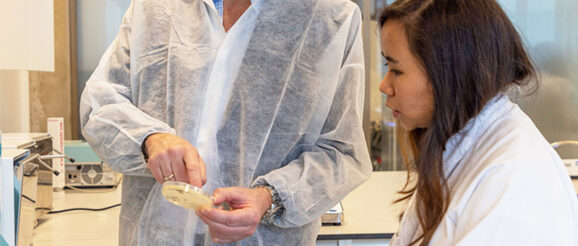Kerry opens innovation hub in Dutch “Food Valley” to pioneer food preservation solutions

18 May 2023 — Kerry has opened an innovation hub for food protection and preservation in Wageningen University’s “Food Valley” in the Netherlands, pioneering new food waste and clean label ingredient solutions.
The new lab and offices will provide accelerated innovation and validation studies to customers in the region while operating in parallel with the company’s preservation facilities in Tiel, the Netherlands, and its global technology innovation centers around the world.
FoodIngredientsFirst takes a closer look at the facility’s potential with Bert De Vegt, global vice president for Food Preservation & Protection at the international taste and nutrition company.
“Innovation in both clean label and conventional preservation can take time due to the extensive validation of these food safety solutions in application. Our hub brings together the ability to isolate the strains that are limiting quality or shelf life and efficiently screen the efficacy of our broad and market-leading ingredients portfolio,” he explains.
“The facility will allow us to accelerate projects into new applications – our lab and offices will give us a closer connection to our customers with the ability to carry out many of their requests through this nimble team that joins our network of R&D labs worldwide.”
A pinch of salt?
Salt is a natural preservative commonly applied to meat and other dehydrated foods to inhibit bacteria growth through decreased water activity. But global health policies are encouraging reduced sodium intake and helping drive demand for clean label alternatives.
“‘No additives or preservatives’ is a common bucket for claims that reflect consumer desire for natural foods with familiar ingredients. However, consumer understanding of the function of various ingredients on the label is often quite limited,” says De Vegt. De Vegt (left) with Therese O’Rourke, CTO – Kerry Europe and Albert McQuaid, Global Chief Science & Technology Officer at Kerry.
De Vegt (left) with Therese O’Rourke, CTO – Kerry Europe and Albert McQuaid, Global Chief Science & Technology Officer at Kerry.
“Familiar kitchen cupboard ingredients often have a proven and natural preservative effect, including salt, vinegar, lemon juice, pickling, fermentation and sugar. Food businesses can use natural ingredients to extend shelf life, avoiding consumer-perceived additives.”
“Adjustments to other factors such as temperature, pH or ingredients can also increase shelf life. These ingredients can be conventional preservatives or clean label alternatives.”
Meanwhile, rising inflation and the cost-of-living crisis mean consumers want more value for their food purchases. Innova Market Insights crowned “Redefining Value” as its top F&B trend for 2023.
“We see a greater acceptance of conventional preservation ingredients on the label among the majority of consumers, as their needs evolve and a greater focus goes on affordability and convenient shelf life and storage possibilities,” continues De Vegt.
“When salt is removed or reduced in a food formula, the conditions for bacteria to grow also become more favorable. Having one less hurdle to inhibit bacterial growth can mean a shorter product shelf life. This problem must be considered when designing processes and ingredients to maintain food safety.”
Fighting food waste
According to the UN Food and Agriculture Organization, one-third of food produced for human consumption is lost or wasted globally, equating to approximately US$1 trillion. For De Vegt, food waste is a problem of scale.
The scale of waste matters because the inefficient use and distribution of the planet’s resources mean that many people today do not have enough food to eat. Moreover, food production and waste are big contributors to greenhouse gas emissions.
“With populations growing, so is the scale of the problem. Kerry’s efforts to increase food’s ability to feed people instead of ending up as waste by extending its shelf life will become more important,” he says. Kerry is witnessing greater acceptance of conventional preservation ingredients like salt amid heightened affordability concerns.
Kerry is witnessing greater acceptance of conventional preservation ingredients like salt amid heightened affordability concerns.
“Studies show that up to half of consumer food waste could be prevented through shelf life extension. The other half is influenced by consumer behavior. Therefore, we believe that formulating foods that consumers want to eat goes hand in hand with shelf life extension when trying to solve food waste at the stages of the supply chain.”
Meanwhile, a lack of efficacy in European food labeling systems also contributes to the food waste problem.
“Our consumer research in Europe shows us that the public has a limited understanding about the difference in best-before and use-by dates,” notes De Vegt.
“Education campaigns and on-pack information to empower consumers to use common sense and their senses to identify and use products that are edible after a best-before date can make a huge difference to household food waste. Where there is uncertainty about a food’s safety, caution and food waste will follow.”
Food preservation’s future
Processes such as high-pressure processing and tunnel pasteurization are popular preservation methods in many parts of the world. However, Kerry is unconvinced about their sustainability into the future due to high capital expenditure and water and energy use.
“We expect to see progress in shelf life extension, which can be achieved with ingredient-based solutions without compromising on quality and taste,” continues De Vegt.
“We also expect new ingredient innovations for a better ability to replace conventional preservatives, such as sorbates and benzoates with naturally derived alternatives.”
With its new hub in the center of Wageningen University’s campus – “the heart of innovation for the food industry” – Kerry aims to attract the right talent to find sustainable solutions to food waste.
“It helps us to join the dots between academia and industry – we already have some interesting research partnerships with the university,” adds De Vegt.
By Joshua Poole
To contact our editorial team please email us at
[email protected]
